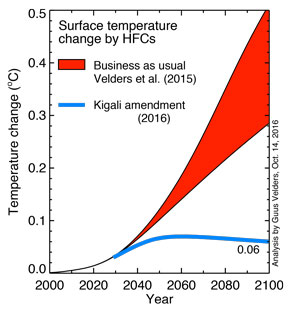A .gov website belongs to an official government organization in the United States.
A lock () or https:// means you've safely connected to the .gov website. Share sensitive information only on official, secure websites.
16 October 2016

On October 15th representatives from more than 170 countries met in Kigali, Rwanda and passed the Kigali Amendment to the Montreal Protocol to regulate future hydrofluorocarbons (HFCs).
Under the Montreal Protocol of 1987 and its later amendments, countries have agreed to phase out most ozone-depleting substances. HFCs are substitutes for some of those ozone-depleting substances and many are powerful greenhouse gases. Currently they are used in a wide variety of applications including refrigeration, air conditioning, fire extinguishers, and others. The new agreement will direct air conditioning, refrigeration, and other applications towards using only HFCs with a low global-warming-potential or non-HFC alternatives.
HFC regulation is a substantial and easily obtainable goal in the world's efforts to avoid dangerous interference in the climate system. If business were to continue as usual, HFCs would increase Earth's surface temperatures by an estimated 0.5 degree Celcius by the end of the century. The Kigali Amendment limits this increase to only 0.06 degrees Celsius.
Furthermore, the agreement is legally binding, multilateral (that is, it applies to all countries), and fully funded, which distinguishes it from other previous or ongoing efforts to curb climate change. The Amendment includes provisions for developed countries to provide financial support to developing countries in their efforts to comply with the Amendment.
NOAA/OAR plays a strong role in the Montreal Protocol's the Scientific Assessment Panel, which provides the scientific basis for Protocol decisions and has supported these negotiation activities since 1987. Dr. David Fahey, director of the Chemical Sciences Division of OAR's Earth System Research Laboratory, is a co-chair of this Panel. The Scientific Assessment Panel is charged with providing scientific information related to the processes that cause ozone depletion; evaluating emissions, atmospheric abundances, and trends in ozone-depleting substances; studying issues related to climate and the ozone layer; and estimating the recovery of the ozone layer under different scenarios.
Scientists from several labs throughout NOAA as well as the Cooperative Institute for Research in Environmental Sciences (CIRES) at the University of Colorado Boulder have also played key roles in advancing the understanding of the ozone layer, including its links to climate change. When scientists first suggested that chlorofluorocarbons (CFCs) were depleting the ozone layer, NOAA led studies that elucidated the processes involved in global ozone depletion and determined the cause of the Antarctic ozone hole. NOAA scientists also monitor the state of the ozone layer and they track, weekly, the concentration of ozone-depleting substances in the atmosphere. They also model the past and projected future state of the ozone layer, evaluate the ozone-depletion and global-warming potentials of chemicals being considered for widespread use, and examine the link between ozone layer recovery and climate change.